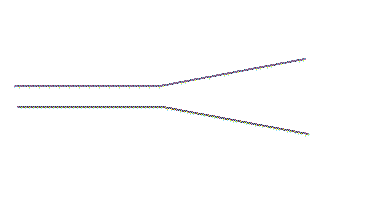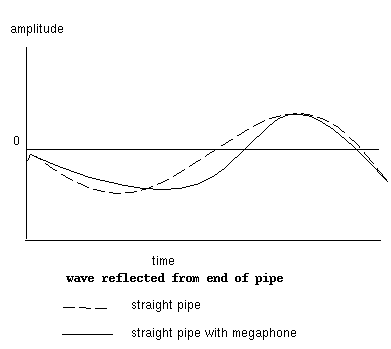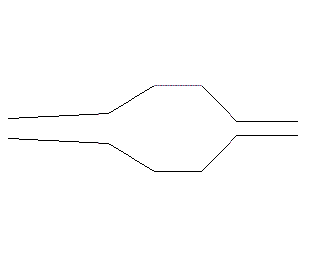| By Eric Murray
You know that changing the exhaust pipes on your two-stroke
motorcycle can have a marked effect on the engine's power
characteristics, but do you know why?
Simply put, it's because the two-stroke exhaust system, commonly
referred to as an 'expansion chamber' uses pressure waves emanating from
the combustion chamber to effectively supercharge your cylinder.
In reality, expansion chambers are built to harness sound waves (created
in the combustion process) to first suck the cylinder clean of spent
gasses--and in the process, drawing fresh air/gas mixture (known as 'charge')
into the chamber itself--and then stuff all the charge back into the
cylinder, filling it to greater pressures than could be achieved by
simply venting the exhaust port into the open atmosphere. This
phenomenon was first discovered in the 1950s by Walter Kaaden, who was
working at the East German company MZ. Kaaden understood that there was
power in the sound waves coming from the exhaust system, and opened up a
whole new field in two-stroke theory and tuning.
An engine's exhaust port can be thought of as a sound generator. Each
time the piston uncovers the exhaust port (which is cut into the side of
the cylinder in two-strokes), the pulse of exhaust gases rushing out the
port creates a positive pressure wave which radiates from the exhaust
port. The sound will be be the same frequency as the engine is turning,
that is, an engine turning at 8000 rpms generates an exhaust sound at
8000 rpms or 133 cycles a second--hence, an expansion chamber's total
length is decided by the rpm the engine will reach, not displacement.
Of course those waves don't radiate in all directions since there's a
pipe attached to the port. Early two strokes had straight pipes, a
simple length of tube attached to the exhaust port. This created a
single "negative" wave that helped suck spent exhaust gases
out of the cylinder. And since sound waves that start at the end of the
pipe travel to the other end at the speed of sound, there was only a
small rpm range where the negative wave's return would reach the exhaust
port at a useful time: At too low of an rpm, the wave would return too
soon, bouncing back out the port. And at too high of an rpm, the piston
would have traveled up the cylinder far enough to close the exhaust port,
again doing no good.
Indeed, the only advantage to this crude pipe system was that it was
easy to tune: You simply started with a long pipe and started cutting it
off until the motor ran best at the engine speed you wanted.
So after analyzing this cut-off straight-pipe exhaust system, tuners
realized two things: First, that pressure waves could be created to help
pull spent gasses out of the cylinder, and second, that the speed of
these waves is more or less constant, though it's affected slightly by
the temperature of the air. Higher temperatures mean that the air
molecules have more energy and move faster, so sound waves move faster
when the air is warmer.
A complicating factor here is that changes in the shape of the tube
cause reflections, or changes, in the sound waves: Where the section of
the tube grows in diameter, there will be sound waves reflected back
towards the start of the tube. These waves will be the opposite of the
original waves that they reflected from, so they will also be negative
pressure waves. Aha! The next important discovery was made--by gradually
increasing the diameter of the tube, a gradual, more useful negative
wave could be generated to help scavenge, or pull spent gasses out of,
the cylinder.
 Adding Divergent Tubes,
which used to be called "Megaphones," to Two-Stroke Pipes
Helped Make Useful Power Adding Divergent Tubes,
which used to be called "Megaphones," to Two-Stroke Pipes
Helped Make Useful Power
 Putting a divergent cone on
the end of a straight pipe lengthens the returning wave, broadening the
power band and creating a rudimentary expansion chamber. Putting a divergent cone on
the end of a straight pipe lengthens the returning wave, broadening the
power band and creating a rudimentary expansion chamber.
So, to sum up, when the negative wave reaches the exhaust port at the
correct time, it will pull some of the exhaust gases out the cylinder,
helping the engine to scavenge its spent exhaust gas. And putting a
divergent cone at the end of the straight (parallel) "head"
pipe broadens the returning wave. The returning negative wave isn't as
strong, but it is longer, so it is more likely to find the exhaust port
open and be able to pull out the exhaust gases. As with plain, straight
pipes, the total length of the pipe with a divergent cone welded on
determines the timing of the return pulses and therefore the engine
speed at which they are effective. The divergent cone's critical
dimensions are where it starts (the distance from the exhaust port to
the start of the divergent cone is called the "head" pipe),
while the length of the megaphone and the rate at which it diverges from
the straight pipe determine the intensity and length of the returning
wave--A short pipe which diverges at a sharp angle from the head pipe
gives a stronger, more straight-pipe-like pulse. Conversely, a long,
gradual divergent cone creates a smaller pulse of longer duration.
In addition, the negative wave is also strong enough to help pull
fresh mixture up through the transfer ports.
And while adding a divergent cone to the head pipe produced great
tuning advantages, it had its limitations, too: The broader negative
wave from a megaphone can still arrive too early and pull fresh mixture
out of the cylinder. That's exactly the problem that Walter Kaaden had
with the factory MZs. He realized that putting another cone, reversed to
be convergent, on the end of the first divergent pipe would reflect
positive waves back up the pipe. These positive waves would follow the
negative waves back to the exhaust port, and if properly timed would
stuff the fresh mixture that was pulled into the pipe back into the
exhaust port right as the piston closed the port. Kaaden immediately
realized a large power gain, and the expansion chamber was born.
In addition to head pipe length, divergent and convergent cone
lengths, an expansion chamber has three more crucial dimensions. The
length of the straight 'belly' between the divergent and the convergent
cones, the length of the tailpiece 'stinger', or muffler, and the
diameter of the belly section. The stinger acts as a pressure bleed,
allowing pressure to escape from the pipe. Back pressure in the pipe,
caused by a smaller-diameter or longer stinger section, helps the wave
action of the pipe, and can increase the engine's performance. This,
presumably, happens since the greater pressure creates a more dense,
uniform medium for the waves to act on--waves travel better through
dense, consistent mediums. For instance, you can hear a train from a
long way away by putting you ear to the steel railroad track, which is
much denser and more uniform than air. But it also causes the engine to
run hotter, usually a very bad characteristic in two-strokes.
The length of the belly section determines the relative timing
between the negative and positive waves. The timing of the waves is
determined by the length of the straight pipe. If the belly section is
too short, positive waves have a shorter distance to travel, and return
to the exhaust port sooner. This is good if the engine is running at a
higher speed, bad if you want to ride on the street. The diameter of the
belly section is crucial for one simple reason: ground clearance. It's
hard to keep big, fat pipes off the ground, though V-Fours have solved
that for now since two of the pipes exit directly out the back.
 A complete two-stroke
pipe has properly tuned header, convergent, belly, divergent and stinger
sections--a difficult process. A complete two-stroke
pipe has properly tuned header, convergent, belly, divergent and stinger
sections--a difficult process.
As the forces in a two-stroke pipe design have become more
well-understood, designers have been able to create engines that take
more advantage of them and in fact require an expansion chamber to run
at all. For instance, a modern pipe has a gently divergent head pipe to
keep gas velocity high near the port, a second cone of "medium"
divergence, and a third divergent cone with a strong taper. A belly
section connects to multi-angled convergent cones, which should exit in
a straight line into the stinger for good power. As you can see, modern
two-stroke expansion chambers create a complex scenario and are quite
difficult to tune. Stay tuned to upcoming issues of Motorcycle Online
for reviews of software that promises to simplify pipe design.
|